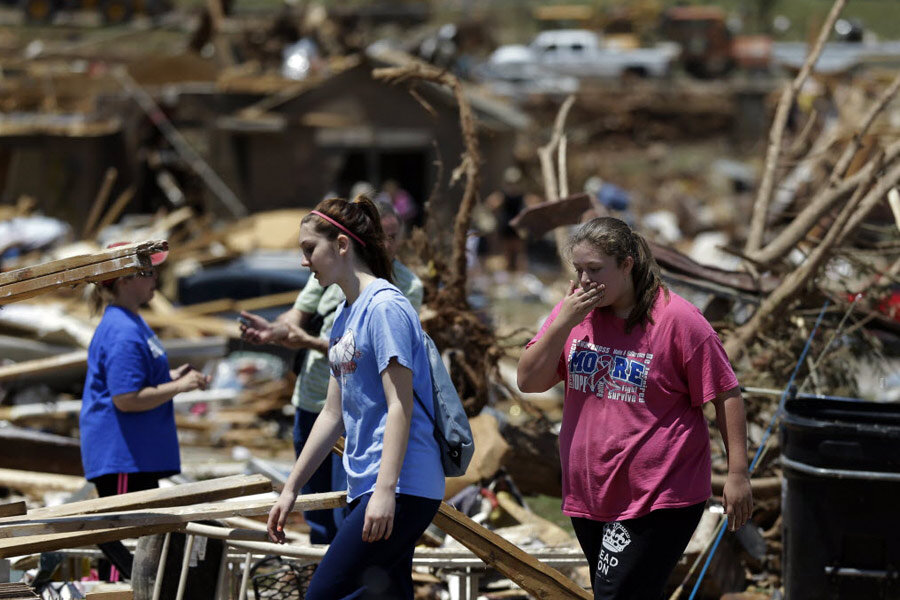How residents of tornado-struck Moore, Okla., have learned to survive
Loading...
| MOORE, Okla.
The bottom line: Experience matters.
Survival in the face of a powerful tornado is never assured, but among residents of the town of Moore, at the historical epicenter of Oklahoma twisters and the site of the state’s first recorded major tornado in the early 19th century, the sense is they’re getting better at it.
On Wednesday officials in Moore exuded a sense of relief as the casualty toll from Monday’s EF5 monster seemed to be cemented at 24, even though 2,500 homes were destroyed.
By comparison, in 1999, a time when the population density in the South Oklahoma City area was lower, an EF5 tornado destroyed 1,800 homes yet killed 40 people.
The damage total, meanwhile, crept toward $2 billion, according to the state's insurance commissioner.
Moore's role as a big tornado bull's eye has turned the Oklahoma City suburb into a unique place, a kind of laboratory of human survivability, residents say.
"We're definitely getting better at surviving," says Moore resident Stephen Hall, who could style himself as a kind of tornado-escape Houdini given four brushes with twisters.
More heads-up warnings, less cries of wolf in the form of overused tornado sirens, more accurate storm tracks, and public awareness, caution, and action have certainly improved casualty rates from big tornadoes, perhaps especially in Moore, where many of those who rebuilt after 1999 installed storm shelters.
More broadly across the country, awareness of tornado precautions is so much better today that the mass casualties in Joplin, Mo., and Tuscaloosa, Ala., in recent years are seen as anomalies.
But in the end, what appears ironically to have saved the most people in the May 20 tornado in Moore was ignoring the government's main piece of advice: Don't try to outrun an oncoming tornado.
Indeed, most people in the tract house neighborhood off Telephone Road, near the epicenter of destruction, simply left. Some drove out of the strike zone, others went to fast-food restaurants, whose walk-in coolers are nearly bombproof and bolted to the earth.
"Yeah, people just leave, that's what I do," says Todd Smith, whose home was barely grazed by the May 20 tornado. "You watch the track, you listen to the warnings, and you make the call and go. That's why everybody buys tornado insurance, so you can go back, pick up the pieces, and rebuild."
"Telling people to run out of the house and get in the car and drive away is not something the government does, but if you listen to [Oklahoma City TV meteorologists], they tell you to get the hell out of there," says Thomas Grazulis, a tornado historian in St. Johnsbury, Vt. "Seventeen minutes is plenty of time to get long way from the path of a tornado."
Local forecasters, adds Mr. Grazulis, have the experience "of knowing who got away and who didn't, and what worked in real time."
Still, to brave a tornado by car requires a sense of perspective and experience, both of which most Tornado Alley natives have in spades. Mr. Hall, for one, has lived through four tornadoes after 42 years in Oklahoma. Those four literally brushed past his life, two coming within yards of his house, and another one that chased his bumper on I-35.
Yet tornado familiarity, in the case of Moore, hasn't bred complacency. Some 100 people were quickly rescued from rubble and buried storm shelters after the storm blew through, with helmeted urban rescue teams on all-terrain vehicles dispatched almost as soon as the wedge twister dissipated northeast of town.
Tornadoes do strike the same place twice, and in the case of Moore it may be as much a function of suburban growth making a larger human target for the runaway wind locomotives, suggests Grazulis.
And it's not that Oklahomans are blasé about the risks, he adds. Instead, they have perspective earned by tornado experience.
"They love it and they're going to rebuild, and they're gritty," he says. "They also have a belief that a tornado is once in a lifetime, which it probably is. It's really, really unique to have a town hit twice by a major tornado. There was nothing much for 100 years and then all of a sudden these two. It's random, but crazy things happen."






